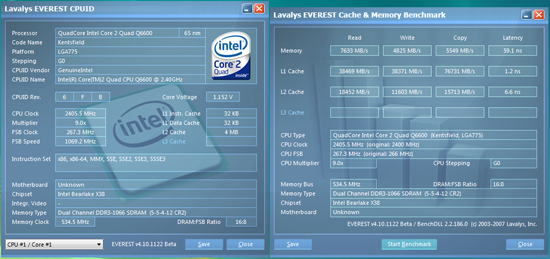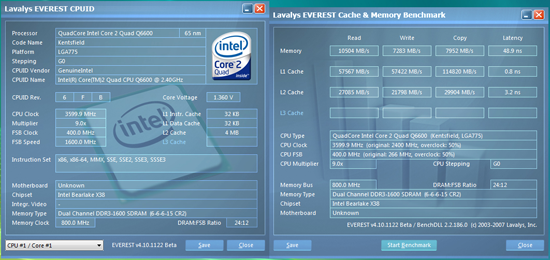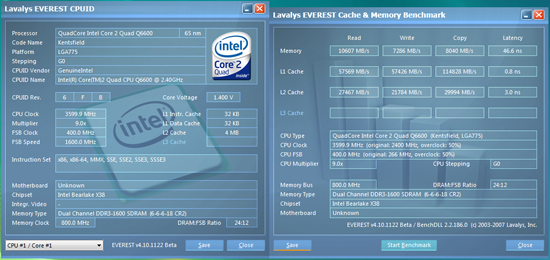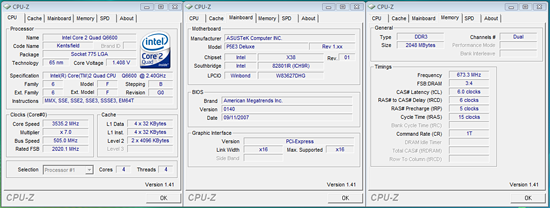ASUS P5E3 Deluxe: X38 and DDR3 arrives... almost
by Gary Key on September 18, 2007 4:00 AM EST- Posted in
- Motherboards
Memory Testing
The Sandra unbuffered scores on the Gigabyte X38 DDR2 board are around 2% better than the ASUS X38 DDR3 board and about 4% better than the abit P35 board. Our Gigabyte board is a production sample board with an early release BIOS. The scores have dropped about 1% from the engineering board we tested previously, although Gigabyte confirms that the BIOS is not fully tuned yet.
We did not expect the memory performance of DDR3 to be this close to the DDR2 board as we noticed significant differences on the P35 boards when running DDR3 at 1066. Intel and the board manufacturers have repeatedly said the X38 chipset will show improved performance with DDR3, especially with the 1333MHz FSB CPUs that allow DDR3 to run at stock 1333MHz rates. The latest BIOS spins show this trend and hopefully the retail releases will show the same progress we have noticed over the past couple of days. However, the price differential between the two memory technologies still means the DDR3 boards will be relegated to the very high end of the market for the near future.
Q6600 9x266
Q6600 9x333
Q6600 9x400
Our memory results are very preliminary considering the beta nature of the latest 1.4 BIOS. We are not showing comparisons to the other DDR3 boards until the BIOS is finalized, but at this time it appears performance is generally a few percent better than the X38 DDR2 boards. In the 9x400 results, the top screenshot is with the system set to the 400 strap and the bottom screenshot is with the 333 strap setting. The improvements in chipset latencies result in slightly better read/write/copy numbers and memory latency is improved about 5%, although tRAS timings were increased from 15 to 18. However, we had to increase our MCH voltage by .04V and CPU voltage from 1.375V to 1.41875V.
Speaking of CPU voltages, we had no issues completing our entire benchmark test suite with our Q6600 set to 1.1500V at stock settings, 1.19375V at 9x333, 1.3750V at 9x400, and 1.44375V at 7x505. Even though we are not at liberty to discuss overclocking results at this time, we do have permission to show our top FSB overclock with the Q6600.
We were able to reach a final FSB setting of 505 with our Q6600. This required the 400 strap setting, MCH voltage to 1.77V, and several other BIOS settings that we will discuss in the launch article. The board actually posted our Q6600 at 522FSB, but benchmark stability was not reached until the 505FSB level. We hit 498FSB with 4GB of memory and the same settings. Hopefully the latest chipset spin and BIOS tweaks will improve upon this result. Vdroop averaged around .02~.04V throughout testing with CPU Voltage Damper enabled; without it, we noticed Vdroop around .07V~.09V when overclocking a quad-core CPU.
 |
| Click to enlarge |
The Sandra unbuffered scores on the Gigabyte X38 DDR2 board are around 2% better than the ASUS X38 DDR3 board and about 4% better than the abit P35 board. Our Gigabyte board is a production sample board with an early release BIOS. The scores have dropped about 1% from the engineering board we tested previously, although Gigabyte confirms that the BIOS is not fully tuned yet.
We did not expect the memory performance of DDR3 to be this close to the DDR2 board as we noticed significant differences on the P35 boards when running DDR3 at 1066. Intel and the board manufacturers have repeatedly said the X38 chipset will show improved performance with DDR3, especially with the 1333MHz FSB CPUs that allow DDR3 to run at stock 1333MHz rates. The latest BIOS spins show this trend and hopefully the retail releases will show the same progress we have noticed over the past couple of days. However, the price differential between the two memory technologies still means the DDR3 boards will be relegated to the very high end of the market for the near future.
Q6600 9x266
 |
| Click to enlarge |
Q6600 9x333
 |
| Click to enlarge |
Q6600 9x400
 |
| Click to enlarge |
 |
| Click to enlarge |
Our memory results are very preliminary considering the beta nature of the latest 1.4 BIOS. We are not showing comparisons to the other DDR3 boards until the BIOS is finalized, but at this time it appears performance is generally a few percent better than the X38 DDR2 boards. In the 9x400 results, the top screenshot is with the system set to the 400 strap and the bottom screenshot is with the 333 strap setting. The improvements in chipset latencies result in slightly better read/write/copy numbers and memory latency is improved about 5%, although tRAS timings were increased from 15 to 18. However, we had to increase our MCH voltage by .04V and CPU voltage from 1.375V to 1.41875V.
Speaking of CPU voltages, we had no issues completing our entire benchmark test suite with our Q6600 set to 1.1500V at stock settings, 1.19375V at 9x333, 1.3750V at 9x400, and 1.44375V at 7x505. Even though we are not at liberty to discuss overclocking results at this time, we do have permission to show our top FSB overclock with the Q6600.
 |
| Click to enlarge |
We were able to reach a final FSB setting of 505 with our Q6600. This required the 400 strap setting, MCH voltage to 1.77V, and several other BIOS settings that we will discuss in the launch article. The board actually posted our Q6600 at 522FSB, but benchmark stability was not reached until the 505FSB level. We hit 498FSB with 4GB of memory and the same settings. Hopefully the latest chipset spin and BIOS tweaks will improve upon this result. Vdroop averaged around .02~.04V throughout testing with CPU Voltage Damper enabled; without it, we noticed Vdroop around .07V~.09V when overclocking a quad-core CPU.










60 Comments
View All Comments
jppoet - Tuesday, September 18, 2007 - link
I though the ICH9R could only provide 6 PCIe lanes?How can the third physical x16 slot be wired with 8 lanes?
Lanes from the ICH9R are also needed for the x1 PCIe slots, each of the NICs and the JMicron JMB363.
Where are all of these PCIe lanes coming from?
JarredWalton - Tuesday, September 18, 2007 - link
I think the X38 is 40 (or 42?) total PCI-E lanes. That would handle the three x16 slots, and the other stuff would come from the SB.hifisoftware - Tuesday, September 18, 2007 - link
What does it mean: ?Will it need some extra heat sinks or just a side fan blowing on existing heatsinks?
JarredWalton - Tuesday, September 18, 2007 - link
It means a down blowing fan (Tuniq 120 is side blowing) might be necessary. However, as this is a preliminary X38 article and the latest respin appears to address heat and power concerns, this may become less of a problem on retail mobos.tynopik - Tuesday, September 18, 2007 - link
page 7> DDR3 boards will be REGULATED to the very high end of the market for the near future
DigitalFreak - Tuesday, September 18, 2007 - link
What's this green team launch on the 25th? A 680i replacement or something on the low end?n0nsense - Tuesday, September 18, 2007 - link
C72 for mainstream and C73 as 680i replacement.later something with HybridSLI support for intel.
takumsawsherman - Tuesday, September 18, 2007 - link
eSata is fine and all, but at this point, can't we just get some Firewire800? Does it really cost that much more? I can understand that a motherboard destined for OEM is going to need to be pared down. These, however, are enthusiast boards. And Firewire lets you daisy chain, which is nice, but Firewire 400 is getting a little long in the tooth, and you are sharing a bus at that point. Tack the $2 on to the price and do it, already.n0nsense - Tuesday, September 18, 2007 - link
I think Mac coming with 800.at least before they switched to intel.
mostlyprudent - Tuesday, September 18, 2007 - link
It's almost laughable how long it's taken to see Firewire800 show up on motherboards. I'm with you - to see a $250 motherboard with Firewire400 instead of 800 is absolutely ridiculous.